商务英语基础上册Unit three教案
- 格式:pdf
- 大小:123.17 KB
- 文档页数:4
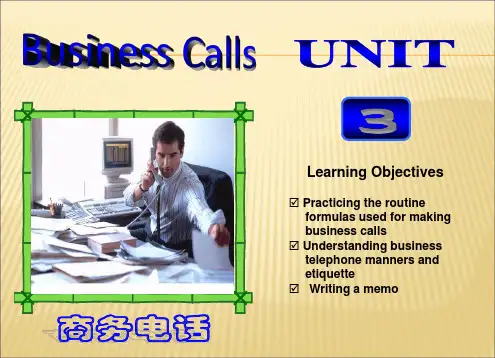
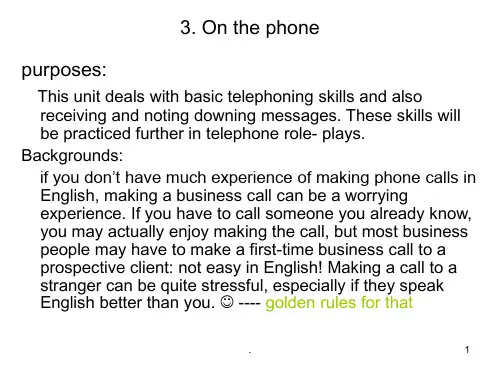
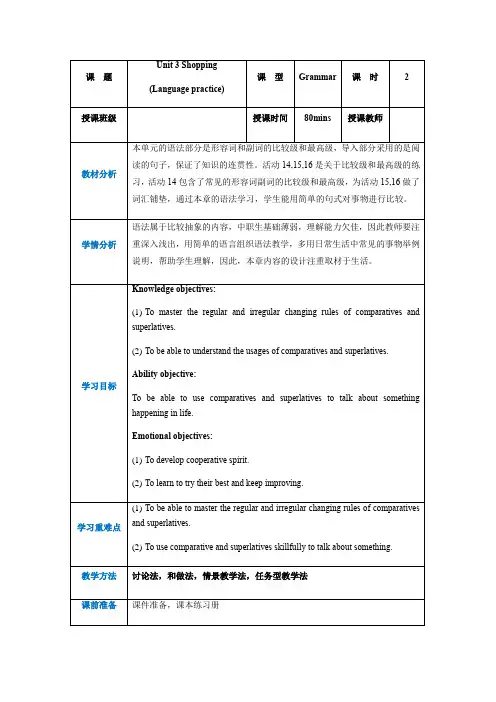
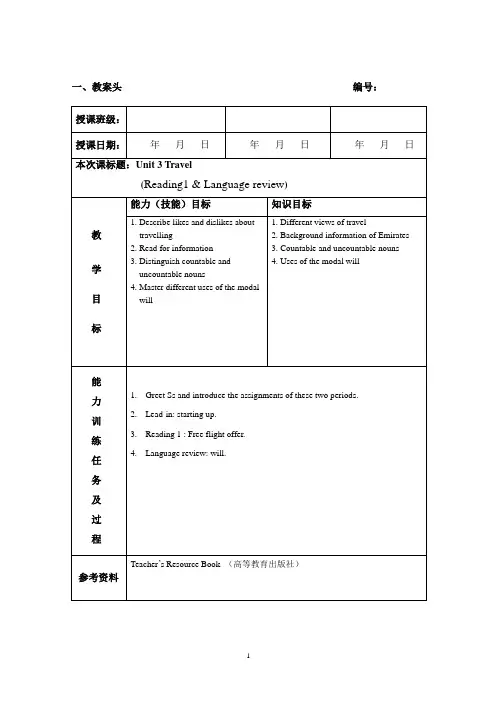
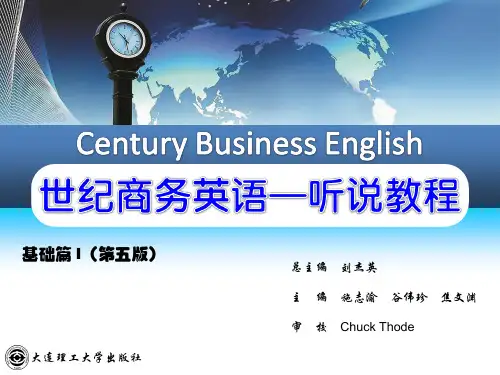


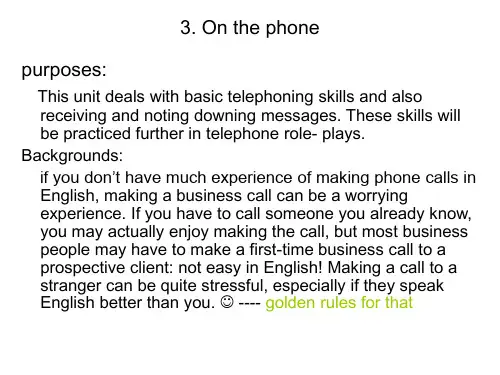

【Title of Lesson】Unit 3 Business Dinner【Text Book】Basic Business English【Teaching Objects and Demands】➢Knowledge and Ability Objects1. To let the students know some basic etiquette knowledge of Western business dinner.2. To let the students know some words and phrases about business dinner.3. To train the students’ abilities of listening and speaking.4. To train the students’ abilities of using English to make simple dialogues about business dinner.➢Procedure and Method Objects1. Through self-study, train students’ abilities of analyzing problems, solving problems and summarizing problems.2. Through group activities, train students’ team spirit ofmutual cooperation and to improve their communication ability.3. Through the competition, train stude nts’ sense of competiting and participating actively, stimulate students’ interests in learning, improve their abilities to adapt to change and enhance their thinking abilities .➢Moral and value Objects1. To enable the students to understand the importance of knowing how to organize or go to a business dinner.2. To lay the foundation for the future English communication.【Teaching Key Points】1. Some words and phrases about business dinner.2. Some sentences about business dinner.【Teaching Difficulties】How to enable students to get to act properly in a business dinner.【Teaching Aids】Multi-media computer, cards and some exercise papers; Software: Microsoft PowerPoint【Teaching Methods】Interactive teaching (learning--reciting –utilizing), discussion, questions & answers methods with the help of some games and activities.【Teaching Periods】180 minutes ( 4 Lessons)【Teaching Procedures】Step 1: Lead-in1. Show a picture of “Lunch Menu”, ask the Ss to try to order some food.。

课题:Unit 3 Placing Orders 教学目的:After learning this unit, students will learn how to 1. To place an order after acceptance 2. To talk about the availability of goods 3. To offer help to solve the shortage of supply by recommending a substitute. 教学重点、难点:Teaching focus 1. Sentence patterns to place an order after acceptance 2. V ocabulary building: terminology about placing orders including good, order and stock. Teaching difficulties 1.To let students understand how to place an order 2. Sentence patterns to place an order and ask for the quality of goods教学方法:1. Situational Teaching Approach 2. Lecturing method 3. Group Activity Approach 4. Task-based Approach 教学器材、设备:1.Multi-media classroom 2.Projector 3.microphone puter 教 案 续 页 第 页教 学 步 骤、内 容Unit 1 Making EnquiriesPart 1Task1: IntroductionFirst, the teacher show a video about placing orders in Chinese to make students understand the procedures. Then show another video about placing orders in English. Then let the students talk about the procedures to placing orders with the words and vocabularies on page 45. Task 2: Discussion1.Ask the students to talk about the questions in lead-in in pairs; 2.Divide the class into small groups and get students to share their own idea; 3. Invite some students to share with the whole class. Task 3: Pre-listening activities1. Learn the words and phrase on page 45. 2. Read the vocabulary to the class and explain them one by one. 3. Let the students learn these vocabulary by themselves. Part 2 listening and speaking 1Task1: listening1. Let the students guess the blanks in the text book. 2. Listen to the mp3 and filling the blanks in the text book. 3. listen again and try to fill all the blanks 4. Listen and fill in the blanks in the text book. Task2:sample dialogues and monologue1. Lead in. Let students read the sample dialogues in pairs;2. Teach the students words and phrases in the dialogues;3. Choose two groups of students to perform in front of the class.Task3: Speaking1. 1. Have Have Have the the the students students students read read read these these these sentences sentences sentences by by by themselves themselves themselves and and and write write write down down down their their answers. 2. Have the students check the answers in pairs. 3. Give them the correct answer. Task4:practice1. Have the students translate the sentences from Chinese to English by themselves. 2. 2. Let the students work in pairs to talk about how to place an order and write Let the students work in pairs to talk about how to place an order and write them down; 3. Talking about considering placing an order and confirming the order; 3. Talking about how to make some changes on the order; 4. Offering help to solve the supply shortage. Part II listening and speaking 2Task 1: listening1. Get students to do the exercises on P52; 2. Check the answers. 3. Summary: Summarize what students have learned in this lesson, point out what they should master. Task 2: Interpreting1. Let the students write down the answers by themselves. 2. Check it with their partners 3. Choose one or two answer to share with the whole class. 4. Give them the correct answer. Task 3: Supplementary reading1. Let the students read the text by themselves;2. Divide them into groups and talk about the answers with their partners.3. Choose one or two answer to share with the whole class. 4. Give them the correct answer. Task 4: Supplementary vocabulary 1. Read the vocabulary to the students 2. Explain some important words in details HomeworkMake Make a a a dialogue dialogue dialogue about about about placing placing placing an an an order order order in in in pairs pairs pairs and and and write write write it it it down. down. down. Read Read Read the the passage in page 252. 。

一、教案头授课班级:授课日期:年刀 日年刀 日年 月 日本次课标题:Unit 3 Travel(Case study and Writing)能力(技能)目标知识目标1 ・ Comprehend the definition of 1. Definition of seminar教seminar2. Background information of IDP2. Understand the background of IDP3. Arranging the seminar3. Role play of arranging the seminar4. Writing an e-mail 字4. Write an e-mail to the manager ofthe hotel目标1. Greet Ss and introduce the assignments of these two periods.2. Lead ・in: Review what they have learnt.3. Case study: The team-building semina 匚4. Writing an e-mail.Teacher's Resource Book (高等教育出版社)参考资料能 力 训 练 任 务 及 过 程编号:二、教学设计步骤教学内容Activities (学生活动)Time(时间)告知(教学内容、目的)1.Lead-in: Review what they have learnt.2.Case study: The team-building seminar3.Writing an e-mail.讲授2m引入(任务项H)Lead-in: Review what they have learntAsk Ss to answer the following terms:1) air rage 2) luggage 3) crew 4) steward 5) alcohol6) passenger 7 attendants提问Ss are required to answer thequestio ns.5m操练(掌握初步或基本能力)Case study: The team-building seminarA computer software company in Los Angeles is organising ateam-building seminar in Vienna for its managers・情景教学Ss learn this part in groups.20m深化(加深对基本能力的体会)TaskYou are either:Manager, IDP^s travel service ( tum to page 151) or Head,Corporate Travel, Universal Airlines (turn to page 153) Youshould keep these roles throughout the case study.务动学任驱歡Ss have a role play・35m归纳(知识和能力)1 ・ Seminar:2. Vocabulary: key words and useful language associated witharranging the seminar.讲授Ss note down the key points.8m训练(巩固拓展检验)Writing:As Head of Corporate Travel at Universal Airlines, write an e-mail to the manager of the hotel chosen for the team-buildingseminar. Confirm the booking, giving details of the number ofparticipants, arrival and departure times, meals, equipment andany other special requirements.写作练习Ss practise the writing・15m总结1 ・ Comments on having the role play2. Methods of writing an e-mail・归纳讲述Ss make a summaryindividually ・3m作业Ask Ss to write an e-mail to me before Friday. 2m 后记Period III: Case study and WritingSteps (步骤)Methods & Tasks (方法、任务)Introduction Lead-in: Review what they have learntAsk Ss to answer the following terms:1) air rage 2) luggage 3) crew 4) steward 5) alcohol 6) passenger 7 attendantsStep One Background:1)Books closed,find out how many of your Ss have been to Vienna and briefly elicit details.2)Tell Ss the title of the case study is the team-buiding seminar and elicit some of the things a team-buiding seminar might cover 弓who might attend and what the aims might be.3)Write the following on the board, minus the answers in brackets:IDPLos Angeles20ViennaFourFridaySunday4)Tell Ss to open their books and read through Backgroud to find out the significance of each one and check what the tean-buiding seminar in the case study is actually for and what it will consist of.5)Check the answers with the whole class.Step Two Part A1)Make sure Ss realise there are four separate but interlinked stages and that they shouldkeep the same role throughout.2)Put Ss in pairs and assign-or get them to choose-roles・ Give them a few minutes toread through the instructions to Stage 1 and the information file relating to their role,checking any vocabulary in their dictionaries or with you.3)Remind them of their work on telephoning in this unit and in Unit 1, and encouragethem to draw on the language and skills they have covered・4)If possible, sit Ss back-to-back for the role play. Circulate and monitor. If some Ssfinish early , tell them to go on to Stage 2.Part B1)Give Ss a few minutes to read through the fax.2)Tell them to close their books and see if they can remember the names of thehotels (Monarch and Dorfmann),the main points about them ( city centre, 5-star versus countryside outside Vienna, 4-star) and date suggested for the meeting (Wednesday 28 Ausgust).Step Three PartC1)Give Ss a few minutes to read through the instructions to Task 3 and the informationfile relating to their role, checking any vocabularly in their dictionaries or with you.2)Elicit some language for making and changing arrangements and write suggestionson the board.3)In pairs, Ss work with a different partner to the one they worked with Stage 1 ・Again sit Ss back-to-back if possible. Circulate and monito匚4)Tell Ss who finish early to start preparing for Task4・5)With the whole calss, find out what Ss agreed for their rearranged meeting.6)Put Ss playing the same role in small groups and give them a few minutes to preparefor the negotiation.7)Allow plenty of time for feedback and discussion at the end・Step Four Writing:Do the task collaboratively in class, or alternatively set it for homework.Conclusion ments on having the role play2.Methods of writing an e-mail.HomeworkAsk Ss to write an e-mail to me before Friday. postscript。
教学单元讲稿一、复习提问与上次课作业典型问题答疑回顾第2单元跨境电商平台简介,帮助学生了解目前全球范围内最大的几个电商平台的基本情况。
讲解每个小节的课后习题,以点名提问的方式考查学生对重点的把握情况。
二、教学单元名称第三单元《电商平台开店》三、课程导入询问学生是否有开过任何形式的网店,是否有过海淘经验?以此导入点,引导学生积极参与、思考,开店前如何去选择平台?选好平台后开店需要准备些什么资料、有哪些具体步骤等逐步展开本章节的教学内容。
四、分析思路本章节主要涉及到跨境电商开店的三大重难点知识:一,如何选择电商平台;二,网上开店的注册程序;三,不同电商平台的优缺点。
围绕这三个知识点,层层递进,重点突破,了解几大电商平台的基本信息和开店的基本步骤。
五、讲授内容Part 1 Promotion and Marketing●Warming-upLearn the following expressions, and write down their Chinese meanings.(1) free shipping免运费(2) no commission无佣金,不收手续费(3) gross merchandise value营业额,商品交易总值(4) Instagram一个照片分享软件(5) hashtag标签(6) pickup address发件人地址(7) variation选项(8) vocation mode休假模式●ListeningListen to the sentences of marketing and promotion of CBEC, try to fill in the blanks. Pay attention to the key words and expressions.(1) After uploading photos of your product, provide information such as the name, category, price, description, variations, and shipping fee.(2) Auto-replies don’t count in chat response rate. Plus, chat response gets updated twice a day.(3) Check your competitors’ pricing to have a benchmark of how your items should be priced.(4) Once you enable vacation mode, all your listed products will be disabled.(5)Overall, Amazon’s gross merchandise value totaled about $239 billion over the last 12 months.●SpeakingA andB are classmates. They are discussing about the advantages and disadvantages of Shopee. Please try to role play the following dialogue, especially pay attention to the underlined parts. A和B是同学。
Unit 3 Visiting the CompanyI Teaching Aim1 Cognitive Information(认知信息): Greeting and Introduction2 Language Focus(内容重点):1)Word Study: A. orientation, motivation, morale, productivity, invest, describe, performance, frustrated, supervisor, largely, improve, entertain, professional, acknowledgement, feedback; B. attitude, ani-festation, perk, paradigm, foundation, strategic, synonymous, plaque, embody, permeate, psyche, perceive, generative, sustain, fundamental2)Phrases: A. figure ... out, be aware of; B. show up3)Key Words: A. inform, apply, reward; B. priority3 Grammar:句子成分Ⅰ4 Writing(写作技巧): 英文标点符号的使用5 Translation(翻译技巧):词义的褒贬III Background Information1. 企业人力资源管理:员工激励的一般原则和方法激励的作用是巨大的。
美国哈佛大学教授詹姆士曾在一篇研究报告中指出:实行计时工资的员工仅发挥其能力的20%~30%,而在受到充分激励时,可发挥至80%~90%。
要实施有效的激励,还应充分了解员工的需要,按需要去激励。
美国人本主义心理学家马斯洛的需求层次理论指出,在低层次的需求得到相对满足之后,就会产生。
Unit 3 Business Dinner 第一课时教学设计金华实验中学教育集团林赛【Title of Lesson】Unit 3 Business Dinner【Text Book】Basic Business English【Teaching Objects and Demands】Knowledge and Ability Objects1. To let the students know some words and phrases about business dinner.2. To train the students’ abilities of listening and speaking.3. To train the students’ abilities of using English to make simple dialogues about business dinner.Procedure and Method Objects1. Through brainstorm, encourage Ss to think and express their own ideas freely to arouse their interests.2. Through group activities, train students’ team spirit of mutual cooperation and to improve their communication ability.3. Through the competition, train students’ sense of competiting and participating actively, stimulate students’ interests in learning, improve their abilities to adapt to change and enhance their thinking abilities .Moral and value Objects1. To enable the students to understand the importance of knowing how to organize or go to a business dinner.2. To lay the foundation for the future English communication.【Teaching Key Points】1. Some words and phrases about business dinner.2. Some sentences about business dinner.【Teaching Difficulties】How to enable students to order a meal in a business dinner.【Teaching Aids】Multi-media computer, small gifts; Software: Microsoft PowerPoint 【Teaching Methods】Interactive teaching, discussion, questions & answers methods with the help of some games and activities.【Teaching Periods】45 minutes【Teaching Procedures】Step 1: Lead-in(warm-up)1. GreetingsTeacher exchanges greetings with the students and gives some small gifts to them.T:I have a big present here for you—an apple.This is my favourite food.Do you like it?Do you want it?OK,I will give it to the group who finish my tasks best,we will have some competitions.Do you want to win?Do you want to be NO.1?2. Q: What’s your favourite food?Teacher asks some students the same questions repeatedly and then shows some pictures of food on the screen.Task 1:Do you know how to say the following in English?Write the words on your paper.Key words:chicken duck fish beef (Chinese food)beefsteak sandwich hamburger salad (English food)tea beer coffee cocktail orange juice(drink)The group who gave the most answers wins.(Teacher shows the possible words and asks the students to read the words)Task 2:T:As we all know ,doing business over dinner is a good way to build relationship.However,it is not an easy thing.So now suppose you are in a restaurant,match what you think to what you should say.You think1.I want to pay2.I think the fish is good3.I’m not ready to order yet4.I want to choose some soft drinks5.What’s the restaurant’s speciality?6.I want chickenYou saya. Can I have the soft drinks menu,please?b. May I have the bill,please?c. I’d like the chicken,please?d. What do you recommend?e. I recommend the fishf. I need a few more minutesTask 3:Show a picture of “Lunch Menu”, ask the Ss to try to order some food.Teacher: Now you can see a menu, it is for you when you are sitting in a restautant. Have a try to order something to eat. You can practise with the help of your tablemate.T: This is a simple way to order a meal. You know ,in a business dinner ,it is different.So having a proper dinner in business is very important, today we will learn something about business dinner.Step 2: Listening【Teacher’s words】We have learned something about business dinner. Now let’s listen carefully how do the person do when they are having a dinner in the dialogue.Task 4:Listen to the dialogue and fill in the missing words.Ask the students to discuss in groups and do Task 4 together. Ask Ss to say their answers out, one student each group as the representative.The teacher checks the students’ answers and shows out the correct answers on PPT.The students read the following sentences.1. Here are the menu and wine list.2. What are the specialities in this restaurant?3. We have special beefsteak, chicken and fish.4. How would you like to have it, rare, medium or welldone?5. What would you like to drink, coffee or tea?Task 5:Listen to the dialogue for the last time and do Task 5: Answer the questions showed on the screen.What would the customer like to drink?What’s the special food in the restaurant?What do they order for the main course?What dessert do they have?Step 3:Speaking Activity【Teacher’s words】Now we have learned some words and patterns about how to order something in a restaurant. Next we will do pairworks according to the following situations:A. PPT shows a situation and some useful knowledge:Task 6:Situation: 假设你现在正和一位商业伙伴在一家餐厅里,请根据给出的菜单做一对话。